Holland Surname Ancestry ResultsOur indexes 1000-1999 include entries for the spelling 'holland'. In the period you have requested, we have the following 2305 records (displaying 1621 to 1630): Single Surname Subscription | | | Buying all 2,305 results of this search individually would cost £13,486.00. But you can have free access to all 2,305 records for a year, to view, to save and print, for £100. Save £13,386.00. More... |
These sample scans are from the original record. You will get scans of the full pages or articles where the surname you searched for has been found. Your web browser may prevent the sample windows from opening; in this case please change your browser settings to allow pop-up windows from this site. Boys entering Sherborne School
(1869)
The grammar school at Sherborne in Dorset, which doubtless existed from the creation of the diocese of Sherborne in 705, was refounded by king Edward VI in 1550. At the quatercentenary in 1950, a fourth edition of the Sherborne Register was published, listing boys entering the school during those four centuries. In truth, the materials for this register survive but fitfully before 1823; for some years, no names are known; sometimes all that is known is a surname. But from 1823 onwards the lists and the details get steadily more comprehensive. By the 20th century the boys are listed alphabetically by surname under term of entrance. Surname is given in bold, then christian names, name of father (surname and initials) and address; year of birth; house (a, School House; b, Abbey House; c, The Green; d, Harper House (formerly The Retreat); f, Abbeylands; g, Lyon House; h, Westcott House); whether represented the school at cricket (xi), football (xv), shooting (viii), &c.; year of leaving; summary of degrees, career &c.; and (in italics), address as of 1950. Names in the early lists marked with an asterisk are found inscribed on the oak panelling or on the stone walls of the former schoolroom. (F) in the lists indicates a foundationer, receiving free education: after 1827, when this privilege was restricted to boys from Sherborne and neighbourhood, nearly all foundationers were day-boys.HOLLAND. Cost: £4.00.  | Sample scan, click to enlarge
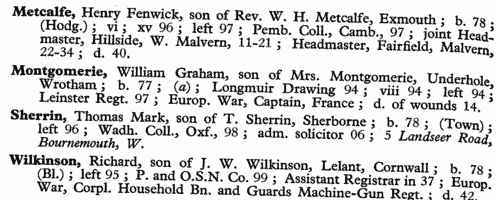
| Boys entering Wellington College in Berkshire
(1869)
Wellington College, near Wokingham, was originally founded for the education of sons of military officers. A register of boys entering the school from First Term 1859 to Michaelmas 1933 was compiled by F. G. Lawrence for the Old Wellingtonian Society. In each entry the boy's name is given in full, in bold, surname first; age at entry (usually 11 to 14); then, in brackets, the name of the dormitory or house to which he belonged, in italics, with the years of his stay; then his father's name (usually surname and initials, but not christian name) with military decorations where appropriate. School prefects and captains are noted as such; if the boy played cricket for the school, XI with the years; academic honours, scholarships, &c.; a brief biography; and date of death, or (where known) address in 1933. Year of marriage is given, and sometimes the wife's name and/or her father's name. Clearly, those boys who kept contact with the school and/or had distinguished military careers have detailed entries; others disappeared into oblivion on leaving.HOLLAND. Cost: £6.00.  | Sample scan, click to enlarge
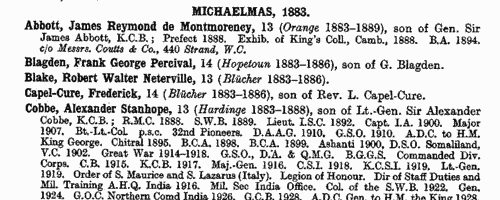
| Members of the Association for Promoting the Extension of The Contagious Diseases Act, in Birmingham
(1869)
The Contagious Diseases Act of 1866 had as its first objective the establishment of isolation hospitals for the treatment of soldiers and sailors afflicted with smallpox, typhoid, measles, chicken pox, malaria, scarlet fever, bubonic plague, dysentery, enteric fever and other infectious conditions. This association was formed to lobby for the extension of the Act to the civil population of the United Kingdom. The membership was drawn not just from the medical profession and those interested in the administration of the poor law, but also from concerned individuals throughout society. The membership list was published alphabetically by area: the scan shows the start of the names for Leicester.HOLLAND. Cost: £6.00.  | Sample scan, click to enlarge
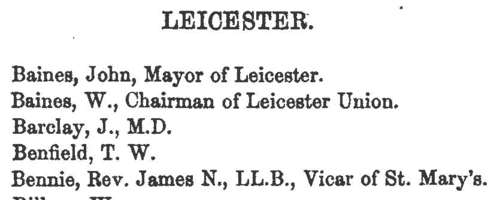
| Printer's widow elected to a pension
(1869)
The Printers' Pension Society was formed 3 December 1827 for 'the relief of aged, infirm, and distressed workmen, and their widows, in the several branches of the printing trade'. This list of pensioners elected through to December 1881 sets out in tabular form sequential number; year of election; full name (surname first); occupation (such as compositor, pressman, warehouseman, &c.); age at election; total amount paid (to December 1881 where still then living); and year of decease. The names of pensioners still alive at the end of 1881 are given in italics. The final column gives the number of husband or of widow in those cases where the spouse appears elsewhere in the list.HOLLAND. Cost: £6.00.  | Sample scan, click to enlarge

| Science Schools and Classes: Elementary Examination: Class Lists
(1869)
The Science and Art Department of the Committee of Council on Education published these class lists giving the names of all the successful candidates in the examination of science schools and classes taken in May 1869. The candidates were of three levels: honours; second stage or advanced examination; third stage or elementary examination. Twenty-three subjects were offered. These are the lists for the elementary examination. The tables, arranged subject by subject, give the candidate's full name (surname first), age, and occupation - or, in the case of those not yet of working age, father's occupation, preceded by (f.). Many candidates sat and were successful in more than one subject, and so appear in more than one list. The subjects are: I. Practical, Plane and Solid Geometry; II. Machine Construction; III. Building Construction; IV. Elementary Mathematics; V. Higher Mathematics; VI. Theoretical Mechanics; VII. Applied Mechanics; VIII. Acoustics, Light, and Heat: IX. Magnetism and Electricity; X. Inorganic Chemistry; XI. Organic Chemistry; XII. Geology; XIII. Mineralogy; XIV. Animal Physiology; XV. Zoology; XVI. Vegetable Anatomy and Physiology; XVII. Systematic and Economic Botany; XVIII. Mining; XIX. Metallurgy; XX. Navigation; XXI. Nautical Astronomy; XXII. Steam; XXIII. Physical Geography. HOLLAND. Cost: £6.00.  | Sample scan, click to enlarge

| Science Schools and Classes: Honours and Advanced Examinations: Class Lists
(1869)
The Science and Art Department of the Committee of Council on Education published these class lists giving the names of all the successful candidates in the examination of science schools and classes taken in May 1869. The candidates were of three levels: honours; second stage or advanced examination; third stage or elementary examination. Twenty-three subjects were offered. These are the lists for the honours and advanced examinations. The tables, arranged subject by subject, give the candidate's full name (surname first), age, and occupation - or, in the case of those not yet of working age, father's occupation, preceded by (f.); the name of the school where the candidate was taught the subject; and the name of the teacher. Many candidates sat and were successful in more than one subject, and so appear in more than one list. The subjects are: I. Practical, Plane and Solid Geometry; II. Machine Construction; III. Building Construction; IV. Elementary Mathematics; V. Higher Mathematics; VI. Theoretical Mechanics; VII. Applied Mechanics; VIII. Acoustics, Light, and Heat: IX. Magnetism and Electricity; X. Inorganic Chemistry; XI. Organic Chemistry; XII. Geology; XIII. Mineralogy; XIV. Animal Physiology; XV. Zoology; XVI. Vegetable Anatomy and Physiology; XVII. Systematic and Economic Botany; XVIII. Mining; XIX. Metallurgy; XX. Navigation; XXI. Nautical Astronomy; XXII. Steam; XXIII. Physical Geography. HOLLAND. Cost: £6.00.  | Sample scan, click to enlarge

|  Men of the 57th Regiment who fought in the New Zealand War
(1860-1870) Men of the 57th Regiment who fought in the New Zealand War
(1860-1870)
New Zealand War Medal roll for the 57th (The West Middlesex) Regiment of Foot: for service in the New Zealand campaign 1863 to 1867: the rolls were compiled following a general order in 1869 and the medals were distributed in 1870. The regiment had been serving at Poonah in India, and was moved to New Zealand in November 1860; the men returned to England in April 1867.HOLLAND. Cost: £8.00.  | Sample scan, click to enlarge

|  Outstanding soldiers of the 100th regiment of Foot
(1860-1870) Outstanding soldiers of the 100th regiment of Foot
(1860-1870)
The 100th (The Prince of Wales' Royal Canadian) Regiment of Foot was raised in Canada in 1858, and proceeded to England; embarked for Gibraltar in 1859; went to Malta in 1863; to Canada in 1866; and to Scotland in 1868. It returned to England in 1869: the regimental depot was on the Isle of Wight. Each year just a handful of outstanding soldiers of the regiment were chosen for good conduct medals and gratuities: these are listed here. There were two lists, one for men recommended for the Good Conduct Medal without a gratuity, and one for gratuities - £5 to a private, £10 to a corporal, and £15 to a serjeant. Both lists are indexed here, and each gives rank, name, regimental number, date of recommendation and date of issue. (The sample scan is from the 105th foot)HOLLAND. Cost: £8.00.  | Sample scan, click to enlarge
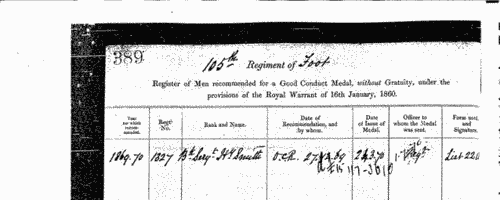
|  Outstanding soldiers of the 42nd regiment of Foot
(1860-1870) Outstanding soldiers of the 42nd regiment of Foot
(1860-1870)
The 42nd (The Royal Highland) Regiment of Foot (The Black Watch) embarked for India in 1857, having fought in the Crimea. It was serving in India in 1860. It helped suppress the Indian Mutiny, taking part in the capture of Lucknow, and returned to England and Scotland in 1868: the regimental depot was at Stirling. Each year just a handful of outstanding soldiers of the regiment were chosen for good conduct medals and gratuities: these are listed here. There were two lists, one for men recommended for the Good Conduct Medal without a gratuity, and one for gratuities - £5 to a private, £10 to a corporal, and £15 to a serjeant. Both lists are indexed here, and each gives rank, name, regimental number, date of recommendation and date of issue. (The sample scan is from the 105th foot)HOLLAND. Cost: £8.00.  | Sample scan, click to enlarge
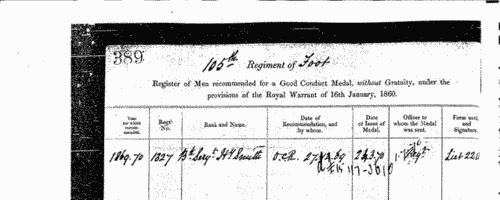
|  Outstanding soldiers of the 44th regiment of Foot
(1860-1870) Outstanding soldiers of the 44th regiment of Foot
(1860-1870)
The 44th (The East Essex) Regiment of Foot embarked for India in 1857, after returning from the Crimea. It was serving in India in 1860. It helped suppress the Indian Mutiny. The regimental depot was at Colchester. Each year just a handful of outstanding soldiers of the regiment were chosen for good conduct medals and gratuities: these are listed here. There were two lists, one for men recommended for the Good Conduct Medal without a gratuity, and one for gratuities - £5 to a private, £10 to a corporal, and £15 to a serjeant. Both lists are indexed here, and each gives rank, name, regimental number, date of recommendation and date of issue. (The sample scan is from the 105th foot)HOLLAND. Cost: £8.00.  | Sample scan, click to enlarge
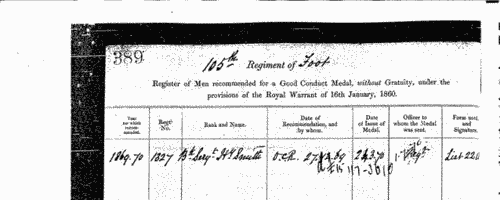
|
Research your ancestry, family history, genealogy and one-name study by direct access to original records and archives indexed by surname.
|













